One of the great pleasures of travel for me is learning about and sampling the local cuisine. Boiling it down even further, street food is considered a right of passage amongst most travelers. It offers a unique insight into a country’s culture, and as far as I’m concerned, Thai street food some of the worlds best in terms of variety and flavor!
An Intro To Thai Street Food
Thai street food is world renown for its flavors. Be it a noodle soup served from a boat in the floating market in the canals of Bangkok (a cant miss part of any Bangkok itinerary) or Moo Ping BBQ Pork on the beaches of Krabi or Koh Samui you’re pretty well guaranteed a delicious meal without being out of pocket too much cash.
Speaking of cash, Street food is an important part of the Thai economy. The state owned government savings bank estimates that tourists purchases of street food alone pump nearly 35 million baht (~1.1 million dollars) into the Thai economy every year!
Thailand is a popular tourist destination with 35-38 million foreign visitors per year. If each tourist spends an average of 1,000 baht on street food, this pumps about 35 billion baht into the economy yearly. Bangkok Post
While it might be cheap, anyone who tells you that they weren’t intimidated the first time they ate Thai street food is probably lying to you. I remember wondering “How do I eat this whole-fish-on-a-stick?” to “why’s my rice purple?” and constantly playing the “whats-that-floating-in-my-noodles” game. While it’s true that some Thai street food can be intimidating (candied scorpions, I’m looking at you) the vast majority is simple and delicious.
I was lucky enough to have an Expat in Bangkok show me the ropes so I’ll share my experiences with you!
Thai Street Food Tips
Thai Street Food is CHEAP! Even in the most built up tourist areas it was uncommon to see a vendor selling meals for more than about 60-80baht ($2-2.50USD). I would have gladly paid double or triple the asking price for most of these dishes but it never seemed to get there. This is one of the reasons its still possible to travel Thailand on a budget, in fact my food costs typically didn’t get above $10/day when I was trying to stick to a budget.
When they say spicy they mean it! Even if you love spicy food you’ll want to take it slow in Thailand. Even a “little spicy” was more than I could typically handle and here at home I love to eat spicy foods. A friend i’d met at the hostel ordered his meal spicy and I couldn’t even sit beside him because the steam was burning my nose and eyes. Slow and steady, you’re better to order it mild and add chili’s, oil or paste as needed after you try it.
Choose your own adventure! Half the fun of Thai street food is dressing it up with the available condiments after you buy it. On almost every vendors stand or tables you’ll find a smorgasbord of sauces, nuts and chilies for your use!
Breakfast? Whats that?! In Thailand breakfast is simply the first meal of the day. Unlike much of the western world where we separate breakfast food into its own category the Thai’s simply cook up whats available or leftover. Except in the more touristy spots of the country you wont find an English breakfast on offer, typically its, noodles, bbq meat with rice or simply fresh fruit. I ended up surviving on passable coffee and mango sticky rice or fruit in the mornings.
Basic Thai Street Food
Lets be honest. If you’re traveling in south-east Asia for the first time a lot of the food here will be overwhelming. Street food in Thailand is no exception, but you can ease your way into this world of culinary delights with these select items.
Roti

Roti is, and always will be, a Thai street food staple. Known by most travelers as Thai pancakes these delicious treats can be found on nearly every street corner, even in the far flung reaches of the country. This a tasty pan-fried bread, is a popular snack and is widely served all over Thailand. Available in both sweet and savory versions they vary in style from vendor to vendor and province to province. The taste however is always a winner!
My sweet tooth to this day still craves the banana and Nutella Roti found along the Krabi coast. I remember it as the perfect breakfast when paired with a decent coffee and fresh fruits.
In the savory camp the green curry Roti was a hit at a roadside stall while perusing Bangkok’s nightlife!
Som Tam – Green Papaya Salad
Kavita Favelle of the culinary travel blog Kavey Eats drops in with a recommendation for some delicious Som Tam!
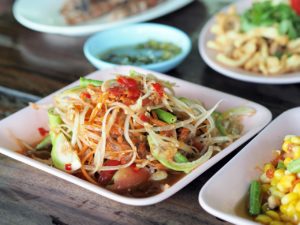
“Green papaya salad aka Som Tam, is a very popular dish in Thailand. The dish originates from North Eastern Thailand, by the Laos border, but today you will find it across the country. Street food vendors do a roaring trade, usually making it to order for each customer, allowing them to control just how much chili is used (be thankful)
At the core of Som Tam is unripe (green) papaya grated or shaved into strands. The salad is prepared in a very large mortar and pestle in which green papaya is tossed together with long or green beans, shredded white cabbage and grated raw carrot, and pounded with the dressing ingredients so that they combine and seep into the bruised salad elements. The dressing is what brings the classical balance of sweet, sour, savoury flavours and is made from palm sugar, lime juice, fish sauce, small tomatoes, Thai chilies, Thai basil, roasted peanuts, garlic and dried shrimp.
In Bangkok, I recommend seeking out Hai Som Tam located on Soi Convent in the Silom district. This casual and inexpensive Issan restaurant specialises in Som Tam, and the menu offers a wide range variations on the classic Som Tam. “
Kway Chap
Rachel of www.explorernations.com recommends a bowl of Kway Chap to satiate your hunger…
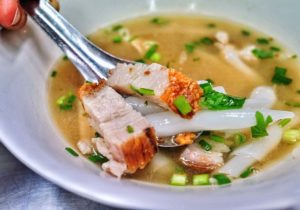
“You’ve never really been to Thailand if you haven’t tried out the renowned Thai Kway Chap. Despite the raves for Pad Thai or Green Curry, this street eat is worth the trip to Thailand. Kway Chap is a mixture of pork and organ soup in a peppery, spicy and pork broth. Compared to any other Thai noodles, this street-eat is rather unique. Typically, you’ll find everything in a bowl, including crispy pork belly, pork slices, pork balls and any pork organs that you can think of. In order to complete this meal, it’s commonly served with Thai special noodles — Nai-Ek Rolled Noodles. It is rice noodles that are rolled-up like the size of your pinky finger. The robust flavour of the broth with mild and light noodles is just a perfect combination. If you’re seeking this savoury snack, head down to Yaowarat aka Chinatown in Bangkok. For the best part, it costs less than just 1.50 USD for a bowl.”
Tom Yum Soup
Sandrina of thewisetravellers.com writes
“One of the most famous dishes in Thailand is Tom Yum soup. The spicy plate gains its name derivate from Thai words Tom (the boiling process) and Yam (Thai spicy and sour salad). Original from Central Thailand, Tom Yum Goong has a distinct hot and sour flavour, with spices and herbs used in the broth. This one made with stock and ingredients like lemongrass, lime juice, fish sauce, kaffir lime leaves and crushed chilli peppers, added with your meat of choice or shrimp.
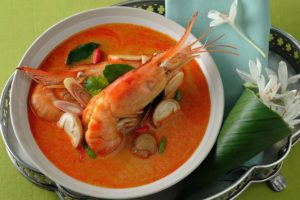
If you are going to Thailand you definitely have to experience the food and this includes Tom Yum Goong, even if you aren’t keen on spicy. Nowadays you will have some variations of the dish to choose from, so no excuses.
From the minute we landed, we had to spoil ourselves, so in Bangkok, we searched for the best place to do it. Don’t worry, the dish is everywhere! In restaurants or street food stalls. We actually like the one from P’AOR , the price ranges between 50baths to 1500THB per bowl (if you want the variation of the soup with a whole lobster).
We also love to eat at a street stall and markets, so we had to go test in one of these locations. Just a stones throw from Khao San Road in the Banglamphu area of Bangkok, Tom Yum Goong Banglamphu food stall (price range 60-140THB) manage to pull one of the ultimate versions of the Thai spicy soup. The place is not as pretty as a fancy restaurant but, you are in Thailand so the best way to enjoy it is to eat in the street.
Tom Yum Goong still gathers a lot of controversy with foreigners, likely because of the intense taste. Some will love it, others will hate it, but everyone should try it!”
Moo Ping
Paul from Chow Traveller suggests trying Moo Ping:
“Moo Ping is a simple Thai snack for those on the go, or for those on a budget. In Thai “Moo” means pork and “ping” means it’s on a stick. It’s basically marinated slices of fatty pork skewered on bamboo sticks. This is then grilled on small portable barbecues which street vendors can set up easily in areas of high traffic. The cilantro, garlic, and peppercorn marinade bring out the absolute best flavors in the pork making it a must eat street food in Bangkok.
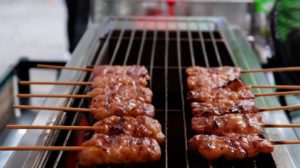
One of my favorite Moo Ping stands in Bangkok is located on the sidewalk of Soi Convent (off of Silom Road) right at the corner of Soi Convent 2. Because of the delicious aromas of fresh barbecued pork it’s tough not to pick up a few skewers when you walk past. The vendor is very jovial, loves to talk to foreigners, and most importantly makes delicious Moo Ping. Each Moo Ping stick costs 10 baht and if you want to make a meal out of it you can get a small plastic bag containing either white or black sticky rice for an additional 5 baht. I bet you can’t eat just one!”
Isaan Sausage
Allan from Live Less Ordinary writes about the cheap and abundant Issan Sausage around Thailand:
“Bangkok’s street food scene is wide and diverse. You’ll find offerings at almost every shop, market and corner in the city. At the same time, many of these street foods aren’t so practical, and it’s really not advised to walk through the streets slurping on noodle soups or downing a papaya salad.
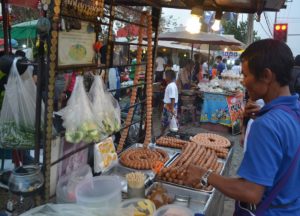
My favorite street food in thailand, which coincidentally can be eaten on the go, is the delicious and plump Isaan Sausage. Named after its origins in the Northeastern (Isaan) region of Thailand a wide range of various sausages found on the streets of Bangkok.
The Isaan Sausage is almost always found in its own individual street food cart. Typically dangling or being cooked over flaming charcoal. This sour sausage, made from fermented pork and sticky rice is squeezed tight in sausage skins. After a good grilling, they are served in a bag along with a skewer stick to grab them with. Topped with other nibbles such as whole green chillies, cuts of ginger, and white cabbage you can combine them as you see fit for a uniquely Thai food taste. Pay around 10 Baht per sausage skewer. “
Mango with sticky rice
Clemens and Anne from travellersarchive.com write about their favorite snack in Thailand
“Whenever we go to Thailand we have this ritual while eating that says “Eat a lot, but leave some room for dessert” – and this dessert is basically always the same, namely “Mango Sticky Rice”. At first it may be a bit odd to think of the combination of a very sweet fruit with rice, but wait until you had it.
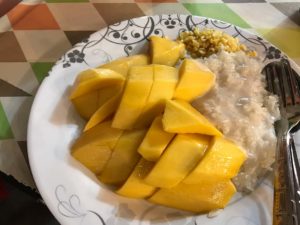
This traditional Thai dessert is made with glutinous rice, fresh mango and coconut milk, and eaten with a fork, spoon, or sometimes the hands. It mostly consists of the sticky rice, which is soaked in water before it’s cooked by steaming or in a rice cooker. At the same time, the coconut milk is mixed with salt and sugar and heated. Once the rice is done, they would put the coconut milk over it, which makes it sweet and sticky. Mostly, you’ll get a plate that consists of a peeled mango, a large portion of sticky rice and extra coconut milk that you can drizzle on top./
You can get mango sticky rice basically in almost any restaurant or nightmarket in Thailand. There are a couple of really traditional places that are famous for their mango sticky rice, such as the ones in the Pom Prap Sattru Phai neighbourhood near Hua Lamphong, but beware that they do stick to the mango season in April and May and are closed for the rest of the year.”
More Adventurous Street Food In Thailand
With the main street food staples in Thailand covered there are a few outliers to acknowledge. ‘Adventurous’ street food if you will. Something that gives you a story to tell friends and family when you get home. A “You wouldn’t believe it, when I was in Thailand I ate…” kind of thing.
Candied Scorpions

When you think about weird street food around the world no doubt one of the images you imagine is bugs on sticks. Street food in Thailand is no different.
Most often found in touristy areas candied, fried or dehydrated scorpions are not for the faint of heart. I couldn’t bring myself to try them, but maybe you’re braver than I am!
Goong Ten (Dancing Shrimp)
Dancing Shrimp is an adventurous Thai street food that could make your stomach squirm. This Northeast Thailand shrimp dish is served raw, doused in a spicy, salty, sour marinade of chili, fish sauce, and lime. Upon applying the acidic lime, the shrimp desperately dance in an effort to escape being the days lunch. While i’m told the dish is delicious once again,it wasn’t for me!
Conclusion
Although you dont have to be an adventurous traveler and try all of the Thai Street food offerings you should do your best to give everything its fair shot! Initially I was admittedly kind of skeptical of some of the dishes. Once I was peer pressured into trying them I was glad I had.
I can honestly say nothing I tried while visiting Thailand was ‘bad’. In fact many of the dishes i’d turned my nose up at in the beginning became favorites i’d go back for time and time again. A little courage can go a long way! So pack your backpack, check in your luggage, buy a cheap plane ticket and get yourself to Thailand to try these dishes for yourself!





My ‘go-to’ breakfast after I QUICKLY got over the English breakfast was a Thai pancake (basically a crepe), fresh fruit and a Coffee Shake. Actually, I could go for that right now!
Many tourists consider Thai food as a complete madness in the world of cooking, but there are dishes that remain in memory for a lifetime.